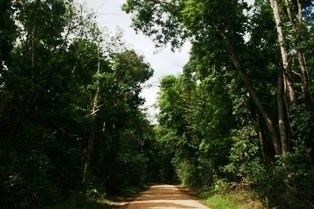Nearest town or city Weipa Phone +61 7 4051 3588 | Area 346 km² Established 1977 | |
 | ||
Managing authorities Website Iron Range National Park Similar Portland Roads Beach Sh, The Greenho, Lockhart River Airport, Australia Post ‑ Lockhart, Lockhart River Arts | ||
Iron Range is a National Park located in Queensland, Australia, 1,940 km northwest of Brisbane and 100 km east of Weipa in the Cape York Peninsula, Queensland. Within the National Park is the Iron Range (Lockhart River Resources Reserve), Scrubby Creek mining site and the Lockhart River Aboriginal Reserve. During World War II several Australian Army units were stationed in the area.
Contents
Birds
The park is part of the 6,205 km2 McIlwraith and Iron Ranges an Important Bird Area (IBA), identified as such by BirdLife International because it is one of the few known sites for the endangered buff-breasted buttonquail. The IBA also supports an isolated population of southern cassowaries as well as populations of lovely fairywrens, silver-crowned friarbirds, yellow, yellow-spotted, white-streaked and banded honeyeaters, and white-browed robins. As well as these, the eclectus parrot subspecies Eclectus roratus macgillivrayi is confined to the Iron and McIlwraith Ranges of eastern Cape York Peninsula.
Airbases
In March 1940, Val Augenson of the Department of Civil Aviation inspected a possible site for an Emergency Landing Ground for the Royal Australian Air Force (RAAF). He reported to the RAAF that a suitable all-weather Emergency Landing Ground could be built in the area.
On about 18 April 1942, Walter Maiersperger, the Commanding Officer of 33 Bomb Squadron of the United States Army Air Forces 22nd Bomb Group, carried out an aerial reconnaissance flight over the Iron Range area. He had been tasked with surveying coastal airfields in Queensland that would be suitable for operation of the B-26 Marauders used by the 22nd Bomb Group.
Air Commodore Lukis, Air Officer Commanding, North East Area, reported on 28 May 1942, that Pilot Officer Trench, RAAF had inspected the countryside near Portland Roads (also known as Weymouth Bay), with Colonel Mills and Captain Herman G. Cox of the USAAF. Their first attempt to fly to the Iron Range area from Coen was not successful. An engine failed in their Rapide and they returned to Coen. After being repaired they took off the next morning and landed on a beach at low tide a few miles south of Portland Roads. As the plane slowed down upon landing on the soft sand the Rapide swung towards the sea. The tips of the propeller started to thrash in the water but the skilful pilot was able to turn the aircraft back onto the beach.
The inspection party reported to Lukis that there were good jetty facilities at Portland Roads but that there was no suitable site for an aerodrome near the jetty. They reported that a fairly extensive site just to the west of Iron Range and east of the Claudie River was suitable for the construction of several airfields. On 7 June 1942, an advance party of the US 46 Engineer General Service Regiment and 26 Operational Base Unit RAAF boarded the SS Wandana in Townsville headed for Portland Roads. 26 OBU arrived at Portland Roads and established radio communications with Townsville on the evening of 10 June 1942.
A few weeks after his initial visit, Jim Trench returned to the Iron Range area with Colonel Mills and observed two American Battalions of Pioneer Engineers busily building the Iron Range runways. They managed to build two 7,000-feet runways and thirteen miles (21 kilometres)of sealed taxiways within three months. On 14 June 1942, Companies A, B and C of the 46th Engineers boarded the MS Dona Nati at Townsville and arrived at Portland Roads on 16 June 1942. Headquarters and Service Company (H & S Company) of the 46th Engineers left Townsville on 10 July 1942 and arrived at Portland Roads on 12 July 1942. On 27 October 1942, Headquarters Detachment of the 46th Engineers left Townsville and arrived at Iron Range on 29 October 1942. The 90th Bombardment Group arrived in Queensland in early November 1942 with their forty-eight (48) B-24D Liberators (variant D). They were initially based as follows at Iron Range, 16 km inland from the port facility of Portland Roads:
Sections and units during World War II
According to Peter Dunn, the following sections were situated at Iron Range:
